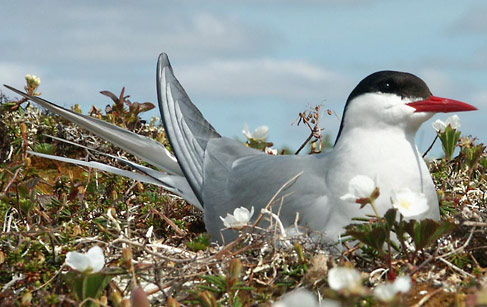| Kingdom: Animalia Phylum: Chordata Class: Aves (Birds) Order: Charadriiformes Family: Laridae |
Arctic Tern (Sterna paradisaea) is a vagrant in India. Size: 33-38 cm Description: Adults in summer: Similar to Common Terns; tarsi considerably shorter; legs red; bill red, without black tip. Adults in winter: White fore crowns, black on the head being largely confined to nape; bills darker. Immatures: Similar to winter adults but tails shorter. Breeding: A depression in the turf or sand, sometimes scantily lined with bits of dried eelgrass or other rubbish, and sometimes without a lining; in colonies, usually mixed with Common Terns. In my experience, islands are selected for nesting rather than mainland beach sites. Eggs: 1-2, usually 2; not readily distinguishable from those of the Common Tern. Remarks: The Arctic Tern is one of the greatest avian travellers. It leaves our shores in autumn for a trans-Atlantic flight to Europe, where it follows the coast southward to its wintering grounds off southern Africa; juveniles continue south to the edge of the Antarctic pack-ice. The recovery of bands from these birds tells amazing stories. A juvenile banded in Maine on 3 July 1913 was found dead on the Niger River Delta in West Africa in August 1917. Another, banded in Labrador as a downy chick on 22 June 1927 was recovered in France on 1 October that year; only three months old, it had flown across more than 5,000 km of ocean. Another banded in Labrador as a chick on 23 July 1928 was found less than four months later on the beach at Margate, Natal, South Africa. It closely resembles Common and Roseate Terns (distinguishing field marks are cited under those species). |
 birding.in
birding.in
| Birds | Bird Diagram | Ornithology | Indian Sites | Bird Watching | Migration | North India | Birds of India | Haryana |
All rights reserved. Copyright © 2005-2013 Birds and birding in India. Disclaimer
website: Free Java Guide & Tutorials
